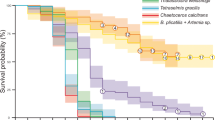Abstract
MANY workers have found the provision of suitable food materials for rearing marine larvæ a major difficulty. Previously, the choice has been limited to marine unicells, of which only Phaeodactylum tricornutum has been widely used for rearing larval annelids. No quantitative feeding investigations have been carried out with annelids comparable to those of Bruce, Knight and Parke1 and Davis2 with oyster larvæ; and those of Raymont and Gross3 and Marshall and Orr4,5 with Colanus finmarchicus. The experimental work reported here was carried out to compare the food values of readily obtained dried organic substances and various unicells (Table 1) for larvæ of Cirratulus cirratus.
Similar content being viewed by others
References
Bruce, J. R., Knight, Margery, and Parke, Mary W., J. Mar. Biol. Assoc. U.K., 24, 337 (1940).
Davis, H., Biol. Bull. Woods Hole, 104, 334 (1953).
Raymont, J. E. G., and Gross, F., Trans. Roy. Soc. Edin., B, 61, 267 (1942).
Marshall, S. M., and Orr, A. P., J. Mar. Biol. Assoc., U.K., 30, 527 (1952).
Marshall, S. M., and Orr, A. P., J. Mar. Biol. Assoc. U.K., 34, 495 (1955).
Author information
Authors and Affiliations
Rights and permissions
About this article
Cite this article
HOWIE, D. Dried Organic Substances as Food for Larval Annelids. Nature 181, 1486–1487 (1958). https://doi.org/10.1038/1811486a0
Issue Date:
DOI: https://doi.org/10.1038/1811486a0
- Springer Nature Limited
This article is cited by
-
Reproduction of a Northumberland population of the polychaete Cirratulus cirratus
Marine Biology (1970)
-
Mass Rearing of Barnacle Cyprids in the Laboratory
Nature (1960)





